The 10 Most Famous Swamp Monsters of Nerd-Dom
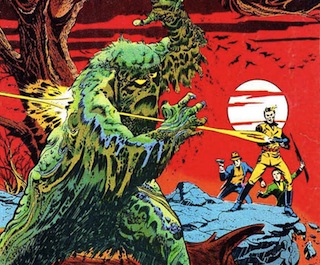 |
You wouldn’t think the concept of a sentient conglomeration of plant matter and mud would be the sort of thing that creator after creator would rush to duplicate (i.e., rip-off). And yet, you can probably think of Swamp-Thing or, if you’re a Marvel fan, Man-Thing right off the top of your head, and you’re well aware of the other company’s similar swamp monster.
While it’s often been debated whether Swamp Thing or Man-Thing was created first, the truth is both of them had a number of predecessors that came oozing out of their respective swamps first, as far back as 1942. There are plenty of true swamp beasts to go around, as it turns out. Here are 10 of nerd-dom’s most famous.
10) It!
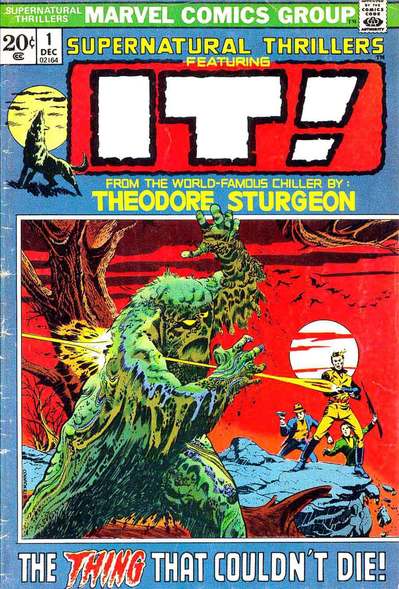 |
The grandaddy of them all, 1940’s “It” is the name of a short story by American science fiction and horror author Theodore Sturgeon. Published in Unknown in August 1940, “It!” tells the story of a man who dies in a swamp. Over the years, the plant life forms around his skeleton to create a shambling, barely-sentient monster. Sound familiar? If not, it will by the end of this list. All swamp monsters basically owe their existence to this story.
The story was adapted for the first issue of Marvel’s anthology horror series Supernatural Thrillers in 1972 by Roy Thomas, Marie Severin and Frank Giacoia.
9) Bog Swamp Demon
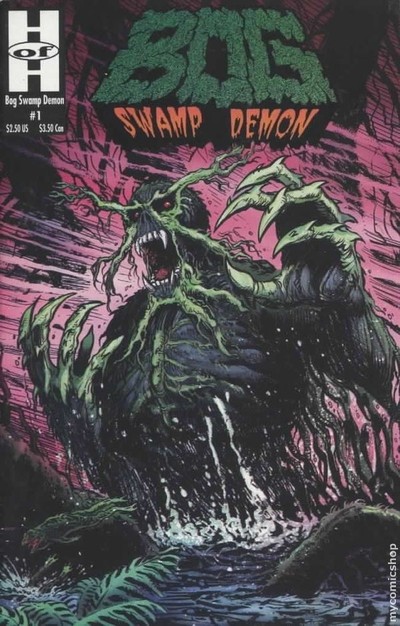 |
The Bog Swamp Demon first appeared as a back-up story in the Mirage Teenage Mutant Ninja Turtles series (specifically volume two, issue six, in 1994). A few years later, Bog got his own miniseries with covers by famed Swamp Thing artist Stephen R. Bissette.
Bog’s character was something of a cross between Swamp Thing and DC’s Etrigan, in that he was a swamp-based demon. His look was essentially a demonized version of Swamp Thing (or Man-Thing, etc.) The story itself was sort of like Swamp Thing meets Spawn, with Bog fighting various demonic threats while occasionally fighting off threats against himself from Heaven.
8) The Glob
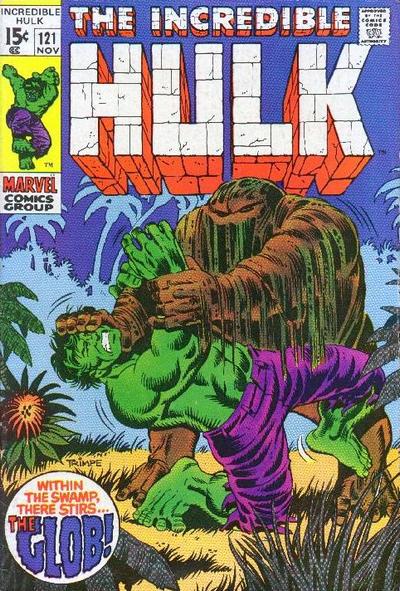 |
Issue #121 of The Incredible Hulk (1969) told the story of Joe Timms, an escaped convict who drowned in a swamp (polluted with radioactive waste for good measure). He was transformed into a pile of semi-sentient swamp muck known as the Glob, who fought the Hulk a few times before being eventually transformed into a clay-based creature. Most recently he was recruited into S.H.I.E.L.D.’s Paranormal Containment Unit.
While his origin is obviously reminiscent of Theodore Sturgeon’s “It” or Solomon Grundy (see below), in many ways the Glob seems to more closely resemble the second Clayface, Matt Hagen, who was introduced in Detective Comics eight years before the Glob’s debut. There was also a second, much shorter-lived Glob in the Marvel Universe, too.
7) Force of Nature
 |
Like Dungeons & Dragons before it, the early editions of Magic: The Gathering borrowed from every aspect of fantasy, science fiction and horror literature in developing its cards. In the early days every color had its own badass creature: red had the Shivan Dragon, black had the Lord of the Pit, blue had the Mahamoti Djinn, white had…well, white didn’t have anything really (until the Serra Avatar showed up years later), and in 1993, green had the Force of Nature.
The Force of Nature was expensive to cast, and if you didn’t feed it green mana constantly it would turn around and punch you in the throat (metaphorically speaking), but its “trample” ability meant whatever piddly creature your opponent threw in front of it would barely slow it down.
The original edition of Force of Nature had no “flavor text” describing the character, but the art on the card was a very obvious reference to any number of creatures on this list (but most likely Swamp Thing). Later art depicted it as less of a Swamp Thing rip-off and more of a Treebeard-rip off.
6) The Shambling Mound
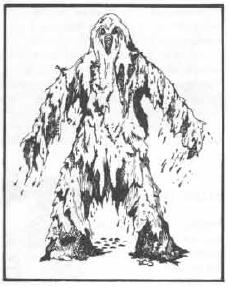 |
First appearing in the official TSR newsletter in 1975, the Shambling Mound later appeared in the very first Monster Manual in 1977. While resembling heaps of rotting vegetation, Shambling Mounds are actually carnivorous plants.
Clearly inspired by the Heap, Swamp Thing and their ilk, the Shambling Mound continues to menace dungeon crawlers to this day.
5) Moss Man
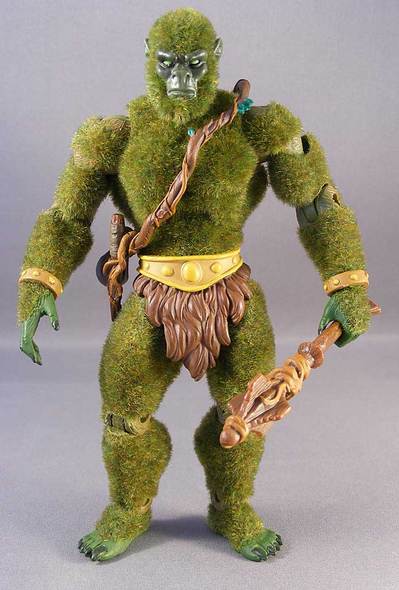 |
Mattel’s mid-1980s Masters of the Universe line was very similar to Dungeons & Dragons in that it borrowed from everything fantasy, science fiction and horror had to offer. So perhaps it’s no surprise that MOTU got its own swamp monster in the form of Moss Man, a nature-loving hero whose action figure was famously covered with a Chia Pet-like coat of green flocking.
In the 1980s cartoon, Moss Man was little more than a spy who could talk to plants and hide himself among them. But for the 2003 cartoon he was given a Swamp Thing-like makeover into a vegetative god with immense powers over nature and plant life. He was so powerful, he could only make rare appearances on the show, because otherwise he’d just defeat the bad guys instantly and there would be little dramatic tension.
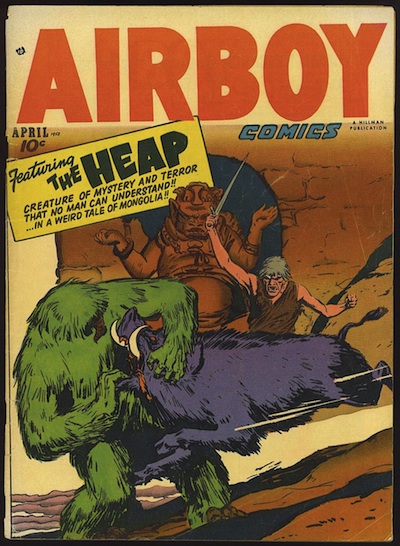 |
In the mid-1990s Todd McFarlane acquired the rights and reimagined the character not as a swamp creature, but as a sentient pile of garbage. Finally, in 2011 Moonstone Books brought back a version of the Heap that appears to be loosely based on his original incarnation.
3) Solomon Grundy
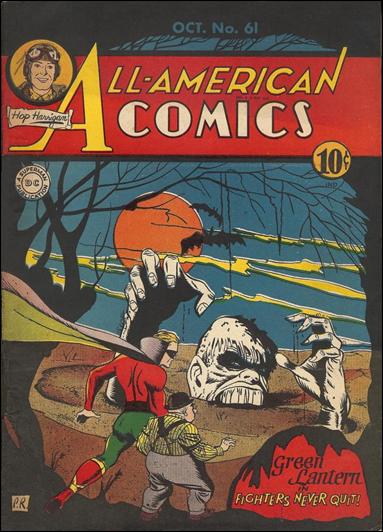 |
Stop me if you’ve heard this one: a wealthy merchant is murdered and his body is disposed of in a swamp, where it is absorbed by swamp matter and reanimated decades later. That’s the origin of DC Comics supervillain Solomon Grundy, who made his first appearance in All-American Comics #61 (October, 1944). Though not traditionally thought of as a swamp monster, DC Comics’s Solomon Grundy owes as much to Theodore Sturgeon’s “It!” as Swamp Thing does.
The rest of his career, however, differs greatly from most other members of this list. Grundy becomes less of a misunderstood outcast and more of a standard supervillain of varying degrees of intelligence. However, at one point it was retconned that he was actually an early attempt by a governing party of plant “elementals” to create a new member of their number (which they eventually succeeded in with Swamp Thing).
2) Man-Thing
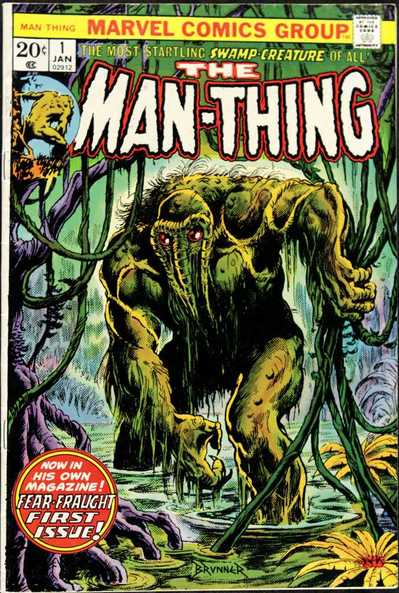 |
First appearing in Savage Tales #1 in May 1971, the Man-Thing was originally Dr. Ted Sallis, a biochemist working to try and recreate the Super Soldier Serum that created Captain America, a task which employs half the scientists working in the Marvel universe. While fleeing from terrorists who are trying to steal the formula, he injects himself with it before crashing his car into a swamp. The chemical combines with magical forces to transform Sallis into the near-mindless Man-Thing. The Man-Thing’s most notable super power is that when it senses fear, it becomes enraged and secretes a corrosive acid.
The character has made many appearances in both comics and various other forms of media, including cartoons, videogames and a Sci-Fi Channel TV movie in 2005… and been the butt of countless jokes for the title of his signature quarterly comic in the seventies, Giant-Sized Man-Thing.
1) Swamp Thing
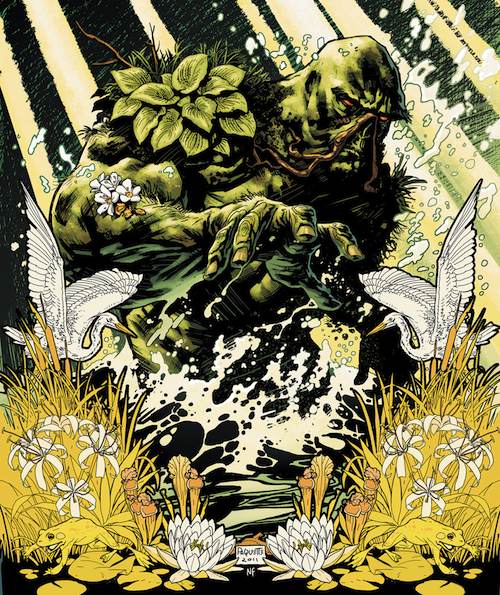 |
While Swamp Thing first appeared after Man-Thing in the June-July 1971 issue of House of Secrets, the story was written before the publication of the first Man-Thing story. However, while the story outlines remain the same, the character who becomes the Swamp Thing is named Alex Olson and the story takes place in the early 20th century.
When Swamp Thing got his own comic in October 1972, the character was made less tragic and more heroic, and his origin updated to contemporary times. The renamed Alec Holland is working on a formula to turn deserts into forests (shades of Star Trek II‘s Genesis Project) when terrorists bomb the lab. Burned and covered with his “Grow-gaine,” Alec jumps into a swamp, where he becomes a humanoid plant creature.
The character became popular enough to warrant a film version by A Nightmare on Elm Street director Wes Craven in 1982. The character was then famously revamped in the 1980s by Alan Moore, where the Alec Holland identity was discarded in favor of depicting the character as a mystical, godlike “Plant Elemental.” In response to Moore’s amazing run of well-crafted, adult storytelling, DC licensed the character for a terrible sequel to the film in 1989, followed by a campy live-action television series, and a short-lived kid’s cartoon in 1991. More recently, Swamp Thing has been relaunched with a new comic and a revised origin as part of DC’s New 52.
